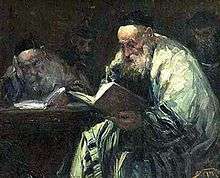Midrash Hashkem
Midrash Hashkem, also known as Midrash ve-Hizhir is a purely haggadic midrash on the Pentateuch. It took its halakic portion from the Talmudic sources, the baraita on the erection of the Tabernacle, the She'eltot of Aḥa of Shabḥa, and the Halakot Gedolot, the She'eltot also being arranged according to the one-year cycle and being in its minor portions especially dependent on Tanḥuma.
Publication Details
The first part of the Munich codex, after which the work was published (by I. M. Freimann, under the title "We-Hizhir." part i., Leipsic, 1873; part ii., Warsaw, 1880), is doubtless somewhat defective. It begins with a haggadic passage, which, belonging to Ex. viii. 16 ("Wa-yomer hashkem ba-boker"), is found also in the earlier editions of Tanḥuma (ed. Stettin, s.v. "Wa'era," p. 14).
Contents
The work was called "Hashkem" after the second word in this introductory sentence. In the editions as well as in the codex this first passage, as well as the beginning of the following haggadic passage to Ex. ix. 22, included in both Tanḥumas in the pericope "Wa'era," is erroneously combined with a passage to Ex. x. 21—which also, perhaps, was taken from Tanḥuma—as belonging to the pericope "Bo" The midrash was called by other authors "We-Hizhir," after the standing formula "We-hizhir ha-Ḳadosh, baruk Hu," with which nearly all the pericopes in the midrash as now extant begin, and which is occasionally found at the beginning of a new section in the middle of the pericope. No one, however, quotes Hashkem and We-Hizhir together as two different works. "The halakic expositions refer in 'Bo' to the tefillin; in 'Beshallaḥ' to the rest on the Sabbath and the 'dine 'erub'; in 'Yitro' to the commandments connected with the Decalogue; in 'Mishpaṭim' to the requirements of the judge; in 'Terumah' to the priestly gift; in 'Wayaḳhel' to the Sabbath; in 'Wayiḳra' to slaughtering; in 'Ẓaw' to the oath and the testimony of witnesses; in 'Shemini' to the 'dine ṭerefah'; in 'Tazria' 'to the 'dine yoledot'; in 'Meẓora' 'to the 'dine ṭum'ah'; in 'Aḥare' and 'Ḳedoshim' to forbidden marriages; in 'Beḥuḳḳotai' to vows; in 'Bemidbar' to the 'dine bekor'" (Zunz, G. S. iii. 258). The haggadic portions are those mentioned above; also part i., pp. 4a et seq. (from the Mekilta); pp. 19a et seq. (from Tanḥuma, ed. S. Buber, and Mekilta); p. 23a (from Mekilta); p. 76b (after Tanḥuma); pp. 115a et seq., 121b (after Tanḥuma); p. 128b (after Tanḥuma, ed. Buber); part ii., pp. 34b et seq. (from Wayiḳra Rabbah, ix.); p. 128b (from Sifra), etc.
The midrash, which ends in the edition with the halakic passage (to Num. v. 11 et seq.) שכל מי שמקניה לאשתו וכו' והזהיר הקב"ה, is probably defective at the end as well as in some other passages (following the manuscript), and it can not be determined whether it covered Book of Numbers only or Numbers and Deuteronomy. Several passages quoted by the old authors, but not found in the edition, may have been included in the missing portion of the work. Zunz, who closely examined the manuscript after which the edition was subsequently printed (l.c. pp. 251 et seq.), comes to the conclusion that We-Hizhir and Hashkem are one and the same work. This view must be unhesitatingly accepted (comp. also A. Geiger's Jüd. Zeit. 1875, pp. 95 et seq.). The fact that some passages quoted by the old authors from the Midrash Hashkem do not correspond entirely with the edition, and that some are not found in it at all, does not prove that these are two different works (as Freimann, Buber, and Grünhut assume). The differences are not important, and both differences and omissions may be due to variations in the copies or to different revisions. The work, which is quoted as early as the middle of the 11th century as a recognized authority, is assigned by Zunz to the tenth century. The assumption of the editor expressed even in the title, that Ḥefeẓ Alluf is the author of the work, lacks support. The quotations from Hashkem by the old authors have been collected by Grünhut ("Sefer ha-Liḳḳuṭim," part i.).
References
 This article incorporates text from a publication now in the public domain: "Midrash Haggadah". Jewish Encyclopedia. 1901–1906.
This article incorporates text from a publication now in the public domain: "Midrash Haggadah". Jewish Encyclopedia. 1901–1906.
